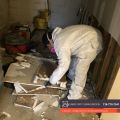Mold in Vents, Basements, Crawl Spaces, and Attics: A Complete Guide to Inspection and Testing

Mold can be a silent yet dangerous problem in many parts of a home, especially in areas like vents, basements, crawl spaces, and attics. These areas are prone to moisture buildup and poor ventilation, which can foster mold growth that often goes unnoticed until it becomes a serious issue. If left unchecked, mold can lead to health risks, structural damage, and costly repairs. Mold inspection and testing are crucial to identifying and addressing mold problems before they escalate.
In this article, we’ll discuss mold growth in vents, basements, crawl spaces, and attics, the importance of mold inspections and testing, and when you should contact a mold specialist.
Common Areas for Mold Growth: Vents, Basements, Crawl Spaces, and Attics
Mold thrives in areas with high moisture levels, poor ventilation, and limited natural light—conditions that are commonly found in vents, basements, crawl spaces, and attics. Here’s why these areas are particularly vulnerable to mold:
1. Mold in Vents and HVAC Systems
Mold can grow inside air vents and HVAC systems due to condensation, moisture accumulation, and dust buildup. When mold grows in these systems, it can easily spread throughout the entire home by circulating mold spores through the air ducts.
- Musty odor when the HVAC system is running
- Visible mold growth around vents
- Increased allergy or asthma symptoms in occupants
- Black or green spots around air ducts or vent covers
Since HVAC systems circulate air throughout your home, mold in your vents can pose a significant health risk. The spores can be easily inhaled, affecting indoor air quality and causing respiratory issues.
Basements are notorious for mold growth due to the constant exposure to moisture from ground contact, poor drainage, leaks, and humidity. Basements often have limited ventilation, making it easier for moisture to accumulate and mold to thrive on walls, floors, and even furniture.
- Persistent musty odors
- Visible mold on walls, ceilings, or floors
- Damp or water-stained surfaces
- Respiratory problems or allergies that worsen in the basement
Mold in the basement can spread to other parts of the home and compromise the structural integrity of the building over time.
Crawl spaces are small, enclosed areas beneath homes that can trap moisture from the ground. Because these spaces are often uninsulated and poorly ventilated, they are a breeding ground for mold, especially if there’s excess moisture from plumbing leaks or groundwater seepage.
Signs of Mold in Crawl Spaces:
- Strong musty odor in the home
- Visible mold on beams, floor joists, or insulation
- Excessive moisture or pooling water in the crawl space
- Pest infestations, which thrive in damp environments
Crawl space mold can travel into the living areas of a home through the air, affecting air quality and potentially causing health issues.
Attics are another common area for mold growth due to poor insulation, roof leaks, and condensation. The warm, humid air that rises into the attic can create an ideal environment for mold, especially if there are ventilation problems.
- Black or green spots on rafters, beams, or insulation
- Damp insulation or moisture buildup in the attic
- Strong, musty odors in upper floors or the attic itself
- Water stains on ceilings or walls below the attic
Since attic mold can compromise the roof structure and insulation, early detection and remediation are crucial.
What You Should Know About Mold Inspections
A professional mold inspection is the first step in identifying and addressing mold problems in your home. While some mold growth may be visible, much of it can remain hidden in walls, under floors, or in vents, making it difficult to detect without specialized equipment.
Here’s what you need to know about a mold inspection:
1. How Mold Inspections Work
A mold inspection involves a thorough visual assessment of your home to identify mold growth and areas prone to moisture buildup. Inspectors use specialized tools such as moisture meters, infrared cameras, and borescopes to detect hidden mold behind walls or under floors. They also look for signs of water damage, leaks, and poor ventilation that could contribute to mold growth.
2. Common Areas Inspected
During an inspection, professionals will examine high-risk areas like:
- Basements, crawl spaces, and attics
- Bathrooms, kitchens, and laundry rooms
- Air ducts, vents, and HVAC systems
- Around windows, pipes, and roofs for leaks
Inspectors may also check the humidity levels in the home and assess the overall air quality to determine the extent of mold contamination.
3. When Mold Testing Is Necessary
If mold is suspected but not visible, mold testing is the next step. Testing involves taking air or surface samples to determine the presence and type of mold. Mold testing helps assess the severity of the contamination, identify the specific type of mold present, and inform the remediation process.
There are two primary types of mold testing:
- Air Sampling: This tests the concentration of mold spores in the air, which is useful for identifying hidden mold that may not be visible.
- Surface Sampling: Swabs or tape samples are taken from suspected mold areas to determine if mold is present and which type.
Mold testing is particularly important if occupants are experiencing unexplained health issues such as allergies, respiratory problems, or headaches.
When You Should Contact a Mold Specialist
Knowing when to contact a mold specialist can help you prevent mold problems from worsening. Here are some scenarios where contacting a professional mold inspector or specialist is necessary:
1. Persistent Musty Odors
If you notice a musty smell in your home, particularly in areas like basements, crawl spaces, or around vents, it’s a sign that mold may be present, even if it’s not visible.
2. Visible Mold Growth
Any visible mold should be addressed immediately. Small patches of mold may seem harmless, but they can quickly spread if the underlying cause (such as leaks or moisture) is not resolved.
3. Health Symptoms
If you or your family are experiencing persistent respiratory issues, allergies, or skin irritation that worsens indoors, mold could be the culprit. In such cases, a mold inspection and testing can help identify the problem.
4. After Water Damage
If your home has experienced water damage due to flooding, leaks, or roof problems, mold is likely to develop in the affected areas. Contact a mold specialist to inspect and test for mold after water damage is repaired.
5. Buying or Selling a Home
During real estate transactions, mold inspections are essential. Mold problems can significantly impact property value and may need to be disclosed to buyers. Testing for mold before buying or selling ensures transparency and can prevent legal disputes.
Conclusion
Mold growth in areas like vents, basements, crawl spaces, and attics can pose serious health risks and structural damage if left unchecked. Regular mold inspections and testing are essential for detecting hidden mold, maintaining indoor air quality, and preventing costly repairs. Whether you notice visible mold, musty odors, or unexplained health symptoms, contacting a mold specialist early can help mitigate the risks and ensure your home is safe.
Contact Bay Area Mold Pros for Professional Mold Inspection and Testing
For reliable and thorough mold inspection and testing services in South San Francisco, San Bruno, San Carlos, San Mateo, Redwood City, Belmont, Millbrae, and Daly City, contact Bay Area Mold Pros. Certified mold inspector Rick Bruce and his team provide expert assessments to ensure your property is safe and mold-free. Request an inspection today at (650) 762-6228 or visit Bay Area Mold Pros to schedule a professional mold inspection and testing service. Protect your property and health with expert mold assessment and remediation services tailored to your specific needs.








